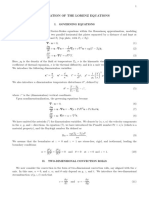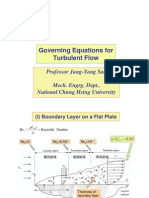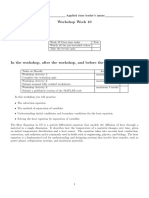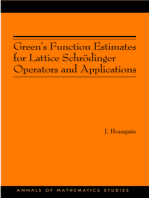0 ratings0% found this document useful (0 votes)
106 viewsVorticity PDF
Vorticity PDF
Uploaded by
irvhenThe document discusses the derivation of the vorticity transport equation from the momentum equation. Some key steps include:
1) Using vector identities to rewrite the momentum equation in terms of vorticity ω = ∇ × u.
2) Taking the curl of both sides yields an equation for the rate of change of vorticity over time.
3) The resulting vorticity transport equation shows that the rate of change of vorticity is controlled by vortex stretching and diffusion.
Copyright:
© All Rights Reserved
Available Formats
Download as PDF, TXT or read online from Scribd
Vorticity PDF
Vorticity PDF
Uploaded by
irvhen0 ratings0% found this document useful (0 votes)
106 views4 pagesThe document discusses the derivation of the vorticity transport equation from the momentum equation. Some key steps include:
1) Using vector identities to rewrite the momentum equation in terms of vorticity ω = ∇ × u.
2) Taking the curl of both sides yields an equation for the rate of change of vorticity over time.
3) The resulting vorticity transport equation shows that the rate of change of vorticity is controlled by vortex stretching and diffusion.
Original Title
Vorticity.pdf
Copyright
© © All Rights Reserved
Available Formats
PDF, TXT or read online from Scribd
Share this document
Did you find this document useful?
Is this content inappropriate?
The document discusses the derivation of the vorticity transport equation from the momentum equation. Some key steps include:
1) Using vector identities to rewrite the momentum equation in terms of vorticity ω = ∇ × u.
2) Taking the curl of both sides yields an equation for the rate of change of vorticity over time.
3) The resulting vorticity transport equation shows that the rate of change of vorticity is controlled by vortex stretching and diffusion.
Copyright:
© All Rights Reserved
Available Formats
Download as PDF, TXT or read online from Scribd
Download as pdf or txt
0 ratings0% found this document useful (0 votes)
106 views4 pagesVorticity PDF
Vorticity PDF
Uploaded by
irvhenThe document discusses the derivation of the vorticity transport equation from the momentum equation. Some key steps include:
1) Using vector identities to rewrite the momentum equation in terms of vorticity ω = ∇ × u.
2) Taking the curl of both sides yields an equation for the rate of change of vorticity over time.
3) The resulting vorticity transport equation shows that the rate of change of vorticity is controlled by vortex stretching and diffusion.
Copyright:
© All Rights Reserved
Available Formats
Download as PDF, TXT or read online from Scribd
Download as pdf or txt
You are on page 1of 4
1
The Vorticity equation
• Use of the streamfunction allows us to automatically satisfy
the continuity equation. Now we will try to transform the
momentum equation
∂u 1
+ (u · ∇)u = − ∇p + ν∇2u
∂t ρ
into an equation for the vorticity ω = ∇ × u.
• Here are a few results that we will use in the derivation:
1
∇(u · u) = (u · ∇)u + u × (∇ × u), (1)
2
∇ × ∇φ = 0, (2)
and
ω · ∇)u − (u · ∇)ω
∇ × (u × ω ) = (ω ω + u∇ ω∇
· ω} −ω
| {z | {z· u}, (3)
0 0
where the last two terms vanish because
∇ · ω = ∇ · (∇ × u) = div curl u = 0
and
∇ · u = 0.
2
• First, we use (1) in the momentum equation to obtain
∂u 1 1 2
+ ∇(u · u) − u × (∇ × u) = − ∇p + ν∇ u
∂t 2 | {z } ρ
ω
i.e.
∂u 1 1
+ ∇(u · u) − u × ω = − ∇p + ν∇2u
|∂t 2 {z } |
ρ {z }
LHS RHS
• Now take the curl of the LHS:
∂ 1
∇ × LHS = (∇ × u) + ∇ × ∇(u · u)} − ∇ × (u × ω )}
∂t | {z } 2 | {z | {z
ω 0 because of (2) see (3)
i.e.
ω
∂ω
∇ × LHS = ω · ∇)u + (u · ∇)ω
− (ω ω
∂t
• ...and the RHS:
1 2
∇ × RHS = − ∇ × ∇p +ν∇ (∇ × u)}
ρ | {z } | {z
0 because of (2) ω
• Now combine the remaining non-zero terms
∂ωω
ω · ∇)u = ν∇2ω .
ω −(ω
+ (u · ∇)ω
|∂t {z }
ω /Dt
Dω
3
• The resulting equation is the vorticity transport equation
Dωω
ω · ∇)u + ν∇2ω
= (ω (4)
Dt
which shows that the rate of change of the vorticity of ma-
terial particles, Dω ω /Dt, is controlled by ‘vortex stretching’
(described by (ω ω · ∇)u; this is a familiar result from inviscid
fluid mechanics) and by diffusion (described by ν∇2ω ). The
diffusion of vorticity only occurs in viscous flows.
• For 3D flows, the first term on the RHS in (4) represents vortex
stretching: velocity gradients lead to a change in the rate of
rotation of material particles.
• Note that for 2D flows, vortex stretching is absent since
u = u(x, y) ex + v(x, y) ey and ω = ω(x, y) ez and therefore
ω · ∇)u = 0.
(ω
• The vorticity transport equation provides an interesting inter-
pretation of the kinematic viscosity ν: The kinematic viscosity
is the diffusion coefficient for the diffusion of vorticity.
• Many phenomena in viscous fluid mechanics can be interpreted
in terms of the diffusion of vorticity but this is (unfortunately)
beyond the scope of this course.
4
• For 2D flows, the vorticity transport equation
Dω
= ν∇2ω
Dt
together with the equation for the vorticity in terms of the
streamfunction
ω = −∇2ψ
and
u = ∂ψ/∂y and v = −∂ψ/∂x
provide the streamfunction-vorticity formulation of the Navier-
Stokes equations, which consists of only two PDEs for the
scalars ω and ψ rather than the three equations for u, v and p
in the ‘primitive variable’ form.
• Scaling arguments show that in the limit of zero Reynolds
number, only one fourth-order PDE for the streamfunction ψ
needs to be solved, namely the biharmonic equation
∇4ψ = 0,
where
4∂4 ∂4 ∂4
∇ = 4 + 2 2 2 + 4.
∂x ∂x ∂y ∂y
• This can also be shown directly by taking the curl of the Stokes
equations.
You might also like
- HGE#003-Hydraulics Engineering 3Document3 pagesHGE#003-Hydraulics Engineering 3Kim Ryan PomarNo ratings yet
- Shell and Tube Heat ExchangerDocument36 pagesShell and Tube Heat ExchangerSiti Nurshahira67% (3)
- Gatapov 2005Document8 pagesGatapov 2005KorcaNo ratings yet
- Afd Note07Document3 pagesAfd Note07zcap excelNo ratings yet
- ShallowDocument5 pagesShallowHamza WELGONo ratings yet
- Navier Stokes Solution IDocument3 pagesNavier Stokes Solution IdsanzjulianNo ratings yet
- Euclid Maa 1175797467Document14 pagesEuclid Maa 1175797467Emerson BelançonNo ratings yet
- 2 Flows Without Inertia: I I J IjDocument19 pages2 Flows Without Inertia: I I J Ijwill bNo ratings yet
- VorticityDocument9 pagesVorticitySwej ShahNo ratings yet
- Intro To SWE Textbook1Document9 pagesIntro To SWE Textbook1AKNo ratings yet
- Turbulencemodels PDFDocument5 pagesTurbulencemodels PDFPawan SharmaNo ratings yet
- A Penalty Method For The Vorticity-Velocity Formulation: Journal of Computational Physics 149, 32-58 (1999)Document27 pagesA Penalty Method For The Vorticity-Velocity Formulation: Journal of Computational Physics 149, 32-58 (1999)Shafqat HussainNo ratings yet
- Derivation of The Lorenz EquationsDocument3 pagesDerivation of The Lorenz EquationsSteven ScottNo ratings yet
- Solucion 01 PDFDocument4 pagesSolucion 01 PDFlibrospiratasNo ratings yet
- Pope Solution 2-9Document3 pagesPope Solution 2-9mwtstumpfNo ratings yet
- GFDL Barotropic Vorticity EqnsDocument12 pagesGFDL Barotropic Vorticity Eqnstoura8No ratings yet
- Multiple View Geometry: Exercise Sheet 10Document2 pagesMultiple View Geometry: Exercise Sheet 10Vard FarrellNo ratings yet
- Chapter 4 SolutionsDocument107 pagesChapter 4 SolutionsKavya SelvarajNo ratings yet
- Governing Equations For Turbulent FlowDocument15 pagesGoverning Equations For Turbulent FlowRenz Marion CorpuzNo ratings yet
- Sketching Streamlines and Lines of Constant Potential Example 1Document6 pagesSketching Streamlines and Lines of Constant Potential Example 1Prince Israel EboigbeNo ratings yet
- BioMEMS Sheet5 ADocument3 pagesBioMEMS Sheet5 Atracywst0123No ratings yet
- CFD IntroductionDocument7 pagesCFD IntroductionThe Bens Mbr 17No ratings yet
- LecturenotesDocument59 pagesLecturenotesTyo Spider-MenkNo ratings yet
- Numerical Computation of A Two-Dimensional Navier-Stokes Equation Using An Improved Finite Difference MethodDocument9 pagesNumerical Computation of A Two-Dimensional Navier-Stokes Equation Using An Improved Finite Difference MethodJino GojuNo ratings yet
- ICNDA My PapersDocument8 pagesICNDA My Papershirakdehingia11No ratings yet
- Chap. 6 Boundary Value Problems in Linear Elasticity: U F U U U F U U UDocument6 pagesChap. 6 Boundary Value Problems in Linear Elasticity: U F U U U F U U USAYEENo ratings yet
- Theory of Vortex Sound With Special Reference To VDocument15 pagesTheory of Vortex Sound With Special Reference To Velvismorey9721No ratings yet
- 2016 - Bourquard - CAPS Technical Note On Acoustic MeasurementsDocument26 pages2016 - Bourquard - CAPS Technical Note On Acoustic MeasurementslakaviyNo ratings yet
- Bona Wu InviscidDocument14 pagesBona Wu Inviscidhaifa ben fredjNo ratings yet
- ChooDocument13 pagesChooCander CyNo ratings yet
- Vorticity: ! Revised Monday, May 5, 2014!Document16 pagesVorticity: ! Revised Monday, May 5, 2014!Steven ScottNo ratings yet
- Introduction To Engineering AnalysisDocument8 pagesIntroduction To Engineering AnalysisSuprioNo ratings yet
- Dirac EquationDocument10 pagesDirac EquationSushruti Richaa KashyapNo ratings yet
- A Fully Discrete Difference Scheme For A Diffusion-Wave SystemDocument17 pagesA Fully Discrete Difference Scheme For A Diffusion-Wave SystemReza AbazariNo ratings yet
- Rans DerivationDocument16 pagesRans Derivationuday gouthamaNo ratings yet
- Chapter 3Document10 pagesChapter 3samik4uNo ratings yet
- 030 - Mit8 - 01scs22 - Chapter30 PDFDocument20 pages030 - Mit8 - 01scs22 - Chapter30 PDFkevinchu021195No ratings yet
- On 2D Viscoelasticity With Small Strain: Zhen LeiDocument25 pagesOn 2D Viscoelasticity With Small Strain: Zhen LeiZahra SamirNo ratings yet
- Jeans Instability and Gravitational Collapse: Fluid Dynamics 101Document7 pagesJeans Instability and Gravitational Collapse: Fluid Dynamics 101SDasNo ratings yet
- Euler KortewegDocument10 pagesEuler KortewegGianfranco GambiniNo ratings yet
- 21 Laplace's EquationDocument15 pages21 Laplace's EquationGovanna StarNo ratings yet
- Taylor GreenDocument2 pagesTaylor Greenafsarul778No ratings yet
- Chapter 2 - The Equations of MotionDocument12 pagesChapter 2 - The Equations of MotionAravind SankarNo ratings yet
- On The Existence of Solution in The Linear Elasticity With Surface StressesDocument11 pagesOn The Existence of Solution in The Linear Elasticity With Surface StressesAbdelmoez ElgarfNo ratings yet
- Paper Stokes TheoryDocument19 pagesPaper Stokes TheoryLeon Lenguitas Muñoz ValdesNo ratings yet
- 1.1 Vector and Integral IdentitiesDocument2 pages1.1 Vector and Integral IdentitiesRevanth VennuNo ratings yet
- Lectures For ES912, Term 1, 2003.: November 20, 2003Document23 pagesLectures For ES912, Term 1, 2003.: November 20, 2003getsweetNo ratings yet
- ENG2005 Workshop W10Document10 pagesENG2005 Workshop W10liamlast2102No ratings yet
- Equations of Turbulent FlowsDocument39 pagesEquations of Turbulent Flowsshehbazi2001No ratings yet
- Nonlinear Programming 3rd Edition Theoretical Solutions ManualDocument26 pagesNonlinear Programming 3rd Edition Theoretical Solutions ManualJigo CasteloNo ratings yet
- 1 Description: 2.1 General FormDocument6 pages1 Description: 2.1 General FormLeo LuisNo ratings yet
- Chapter 6 Differential Analysis of Fluid FlowDocument32 pagesChapter 6 Differential Analysis of Fluid FlowKevin MahardhikaNo ratings yet
- Convection BLDocument77 pagesConvection BLAHMED EL HAMRINo ratings yet
- Di 2016Document7 pagesDi 2016Chương Quách VănNo ratings yet
- Ggerv CcccccsDocument28 pagesGgerv CcccccsAnonymous BrUMhCjbiBNo ratings yet
- Wall Shear Stress and Flow Behaviour Under Transient Flow in A PipeDocument19 pagesWall Shear Stress and Flow Behaviour Under Transient Flow in A PipeAwais Ahmad ShahNo ratings yet
- Calculus of Variations.1Document25 pagesCalculus of Variations.1Osama HassanNo ratings yet
- Lecture One: Harmonic Functions and The Harnack InequalityDocument5 pagesLecture One: Harmonic Functions and The Harnack InequalityMuntazir MehdiNo ratings yet
- Triple Int16 8Document7 pagesTriple Int16 8Nikoli MajorNo ratings yet
- Green's Function Estimates for Lattice Schrödinger Operators and ApplicationsFrom EverandGreen's Function Estimates for Lattice Schrödinger Operators and ApplicationsNo ratings yet
- Mathematics 1St First Order Linear Differential Equations 2Nd Second Order Linear Differential Equations Laplace Fourier Bessel MathematicsFrom EverandMathematics 1St First Order Linear Differential Equations 2Nd Second Order Linear Differential Equations Laplace Fourier Bessel MathematicsNo ratings yet
- The Spectral Theory of Toeplitz Operators. (AM-99), Volume 99From EverandThe Spectral Theory of Toeplitz Operators. (AM-99), Volume 99No ratings yet
- Problem Set 3 MomentumDocument3 pagesProblem Set 3 MomentumRav Christian LlaveNo ratings yet
- A Lifting Line Theory For A Three-Dimensional Hydrofoil: Hui Liang and Zhi ZongDocument7 pagesA Lifting Line Theory For A Three-Dimensional Hydrofoil: Hui Liang and Zhi ZongKoShweBaNo ratings yet
- Pressure Recovery and Loss Coefficient Variations in The Two Different Centrifugal Blower Volute DesignsDocument9 pagesPressure Recovery and Loss Coefficient Variations in The Two Different Centrifugal Blower Volute DesignsJoseph Alexander BorgNo ratings yet
- Pressure Relief Valve DHV 712-R: Nominal Size DN 10-50 Nominal Size 3/8"-2" Nominal Pressure PN 10 BarDocument12 pagesPressure Relief Valve DHV 712-R: Nominal Size DN 10-50 Nominal Size 3/8"-2" Nominal Pressure PN 10 Baralamsyah_syamNo ratings yet
- Volta-HYCOS Training in HydrometryDocument59 pagesVolta-HYCOS Training in HydrometryabimanaNo ratings yet
- Problems 244 294Document14 pagesProblems 244 294Happy Feets50% (6)
- Fans and BlowersDocument33 pagesFans and BlowersVishnupriya B.No ratings yet
- Study of The Performance of The Rotary Dryer With UidizationDocument9 pagesStudy of The Performance of The Rotary Dryer With UidizationRizkha AyuNo ratings yet
- ME612 Computational Fluid Dynamics: Coarse GoalsDocument4 pagesME612 Computational Fluid Dynamics: Coarse GoalsMradul YadavNo ratings yet
- Sop (Orifice Plate)Document18 pagesSop (Orifice Plate)Jhon AlfonsoNo ratings yet
- Engineering and Technology Partner: CADE Soluciones de ingenieria-ESPAÑA - SPAINDocument33 pagesEngineering and Technology Partner: CADE Soluciones de ingenieria-ESPAÑA - SPAINshivakumar bairojuNo ratings yet
- Analisa PipaDocument79 pagesAnalisa PipaPapa BeatrixNo ratings yet
- My Notes On Savitsky Method PDFDocument25 pagesMy Notes On Savitsky Method PDFy_596688032No ratings yet
- Thermal Rating - Single-Phase S&T Heat ExchangerDocument43 pagesThermal Rating - Single-Phase S&T Heat ExchangervictorvikramNo ratings yet
- 2014 Open Channel Final ExamDocument2 pages2014 Open Channel Final ExamnewayNo ratings yet
- ITTC - Recommended Procedures: CFD, Resistance and Flow Uncertainty Analysis in CFD Examples For Resistance and FlowDocument12 pagesITTC - Recommended Procedures: CFD, Resistance and Flow Uncertainty Analysis in CFD Examples For Resistance and FlowSurya Chala PraveenNo ratings yet
- Ammendment To R2 BEPDocument13 pagesAmmendment To R2 BEPpratikNo ratings yet
- Choosing A Line Size and Wall ThicknessDocument29 pagesChoosing A Line Size and Wall ThicknessAndhy Arya EkaputraNo ratings yet
- AssignmentDocument9 pagesAssignmentNikhita BeganiNo ratings yet
- Chapter 12 (Hydro Statics)Document6 pagesChapter 12 (Hydro Statics)Teresa PulgaNo ratings yet
- M.tech (Chem) R13Document54 pagesM.tech (Chem) R13Siva Jagadish Kumar MNo ratings yet
- Viscous Flow Induced by Plates Moving in Opposite Directions: A Finite-Breadth CaseDocument12 pagesViscous Flow Induced by Plates Moving in Opposite Directions: A Finite-Breadth CaseMoslem UddinNo ratings yet
- Inviscid FlowDocument65 pagesInviscid Flowgerry apriliantoNo ratings yet
- 11 SM Physics em 2022 23-283-303Document21 pages11 SM Physics em 2022 23-283-303AkshatNo ratings yet
- Modelling TurbineDocument20 pagesModelling TurbineJeison YarceNo ratings yet
- Osborne Reynold'S Demonstration: Experiment No. - 07Document6 pagesOsborne Reynold'S Demonstration: Experiment No. - 07John Michael Menoza ZapantaNo ratings yet
- E1 PDFDocument7 pagesE1 PDFReinier Roman SantosNo ratings yet
- Topic02 WindLoading PDFDocument40 pagesTopic02 WindLoading PDFAlbert LiuNo ratings yet

























































































